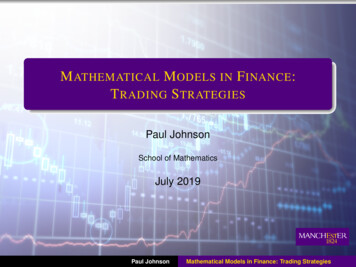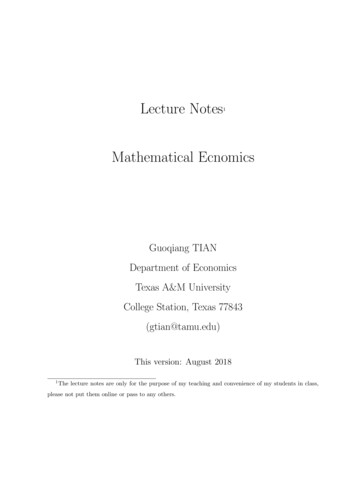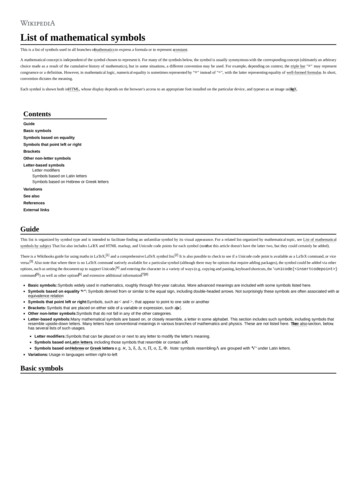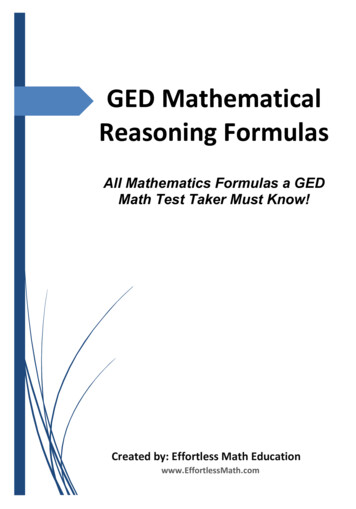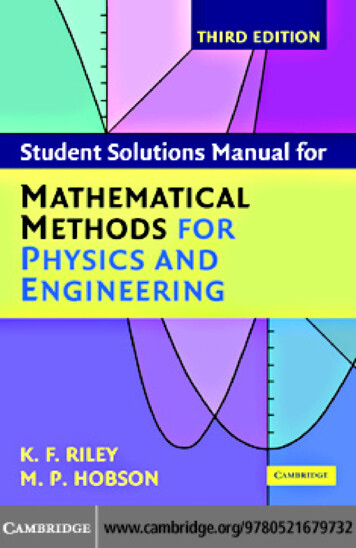
Transcription
0521842077preCB1005/Chen0 521 84207 7This page intentionally left blankJanuary 29, 200614:8
Student Solutions Manual for Mathematical Methods for Physicsand Engineering, third editionMathematical Methods for Physics and Engineering, third edition, is a highly acclaimed undergraduate textbook that teaches all the mathematics needed foran undergraduate course in any of the physical sciences. As well as luciddescriptions of the topics and many worked examples, it contains over 800exercises. New stand-alone chapters give a systematic account of the ‘specialfunctions’ of physical science, cover an extended range of practical applications of complex variables, and give an introduction to quantum operators.This solutions manual accompanies the third edition of Mathematical Methods for Physics and Engineering. It contains complete worked solutions to over400 exercises in the main textbook, the odd-numbered exercises that are provided with hints and answers. The even-numbered exercises have no hints,answers or worked solutions and are intended for unaided homework problems; full solutions are available to instructors on a password-protected website,www.cambridge.org/9780521679718.K e n R i l e y read mathematics at the University of Cambridge and proceededto a Ph.D. there in theoretical and experimental nuclear physics. He became aresearch associate in elementary particle physics at Brookhaven, and then, havingtaken up a lectureship at the Cavendish Laboratory, Cambridge, continued thisresearch at the Rutherford Laboratory and Stanford; in particular he was involvedin the experimental discovery of a number of the early baryonic resonances. Aswell as having been Senior Tutor at Clare College, where he has taught physicsand mathematics for over 40 years, he has served on many committees concernedwith the teaching and examining of these subjects at all levels of tertiary andundergraduate education. He is also one of the authors of 200 Puzzling PhysicsProblems.M i c h a e l H o b s o n read natural sciences at the University of Cambridge, specialising in theoretical physics, and remained at the Cavendish Laboratory tocomplete a Ph.D. in the physics of star-formation. As a research fellow at TrinityHall, Cambridge and subsequently an advanced fellow of the Particle Physicsand Astronomy Research Council, he developed an interest in cosmology, andin particular in the study of fluctuations in the cosmic microwave background.He was involved in the first detection of these fluctuations using a ground-basedinterferometer. He is currently a University Reader at the Cavendish Laboratory,his research interests include both theoretical and observational aspects of cosmology, and he is the principal author of General Relativity: An Introduction forPhysicists. He is also a Director of Studies in Natural Sciences at Trinity Hall andenjoys an active role in the teaching of undergraduate physics and mathematics.
Student Solutions Manual forMathematical Methodsfor Physics and EngineeringThird EditionK. F. RILEY and M. P. HOBSON
cambridge university pressCambridge, New York, Melbourne, Madrid, Cape Town, Singapore, São PauloCambridge University PressThe Edinburgh Building, Cambridge cb2 2ru, UKPublished in the United States of America by Cambridge University Press, New Yorkwww.cambridge.orgInformation on this title: www.cambridge.org/9780521679732 K. F. Riley and M. P. Hobson 2006This publication is in copyright. Subject to statutory exception and to the provision ofrelevant collective licensing agreements, no reproduction of any part may take placewithout the written permission of Cambridge University Press.First published in print format 2006isbn-13isbn-10978-0-511-16804-8 eBook (EBL)0-511-16804-7 eBook (EBL)isbn-13isbn-10978-0-521-67973-2 paperback0-521-67973-7 paperbackCambridge University Press has no responsibility for the persistence or accuracy of urlsfor external or third-party internet websites referred to in this publication, and does notguarantee that any content on such websites is, or will remain, accurate or appropriate.
Contentspage ixPreface1Preliminary algebra12Preliminary calculus173Complex numbers and hyperbolic functions394Series and limits555Partial differentiation716Multiple integrals907Vector algebra1048Matrices and vector spaces1199Normal modes14510Vector calculus15611Line, surface and volume integrals176v
CONTENTS12Fourier series19313Integral transforms21114First-order ODEs22815Higher-order ODEs24616Series solutions of ODEs26917Eigenfunction methods for ODEs28318Special functions29619Quantum operators31320PDEs: general and particular solutions31921PDEs: separation of variables and other methods33522Calculus of variations35323Integral equations37424Complex variables38625Applications of complex variables40026Tensors42027Numerical methods44028Group theory46129Representation theory480vi
CONTENTS30Probability49431Statistics519vii
PrefaceThe second edition of Mathematical Methods for Physics and Engineering carriedmore than twice as many exercises, based on its various chapters, as did the first.In the Preface we discussed the general question of how such exercises shouldbe treated but, in the end, decided to provide hints and outline answers to allproblems, as in the first edition. This decision was an uneasy one as, on the onehand, it did not allow the exercises to be set as totally unaided homework thatcould be used for assessment purposes, but, on the other, it did not give a fullexplanation of how to tackle a problem when a student needed explicit guidanceor a model answer.In order to allow both of these educationally desirable goals to be achieved, wehave, in the third edition, completely changed the way this matter is handled.All of the exercises from the second edition, plus a number of additional onestesting the newly added material, have been included in penultimate subsectionsof the appropriate, sometimes reorganised, chapters. Hints and outline answersare given, as previously, in the final subsections, but only to the odd-numberedexercises. This leaves all even-numbered exercises free to be set as unaidedhomework, as described below.For the four hundred plus odd-numbered exercises, complete solutions are available, to both students and their teachers, in the form of this manual; these are inaddition to the hints and outline answers given in the main text. For each exercise,the original question is reproduced and then followed by a fully worked solution.For those original exercises that make internal reference to the text or to other(even-numbered) exercises not included in this solutions manual, the questionshave been reworded, usually by including additional information, so that thequestions can stand alone. Some further minor rewording has been included toimprove the page layout.In many cases the solution given is even fuller than one that might be expectedix
PREFACEof a good student who has understood the material. This is because we haveaimed to make the solutions instructional as well as utilitarian. To this end, wehave included comments that are intended to show how the plan for the solutionis formulated and have provided the justifications for particular intermediatesteps (something not always done, even by the best of students). We have alsotried to write each individual substituted formula in the form that best indicateshow it was obtained, before simplifying it at the next or a subsequent stage.Where several lines of algebraic manipulation or calculus are needed to obtain afinal result, they are normally included in full; this should enable the student todetermine whether an incorrect answer is due to a misunderstanding of principlesor to a technical error.The remaining four hundred or so even-numbered exercises have no hints oranswers (outlined or detailed) available for general access. They can thereforebe used by instructors as a basis for setting unaided homework. Full solutionsto these exercises, in the same general format as those appearing in this manual(though they may contain references to the main text or to other exercises), areavailable without charge to accredited teachers as downloadable pdf files on thepassword-protected website http://www.cambridge.org/9780521679718. Teacherswishing to have access to the website should contact solutions@cambridge.orgfor registration details.As noted above, the original questions are reproduced in full, or in a suitablymodified stand-alone form, at the start of each exercise. Reference to the maintext is not needed provided that standard formulae are known (and a set of tablesis available for a few of the statistical and numerical exercises). This means that,although it is not its prime purpose, this manual could be used as a test or quizbook by a student who has learned, or thinks that he or she has learned, thematerial covered in the main text.In all new publications, errors and typographical mistakes are virtually unavoidable, and we would be grateful to any reader who brings instances to ourattention. Finally, we are extremely grateful to Dave Green for his considerableand continuing advice concerning typesetting in LATEX.Ken Riley, Michael Hobson,Cambridge, 2006x
1Preliminary algebraPolynomial equations1.1 It can be shown that the polynomialg(x) 4x3 3x2 6x 1has turning points at x 1 and x 12 and three real roots altogether. Continuean investigation of its properties as follows.(a) Make a table of values of g(x) for integer values of x between 2 and 2.Use it and the information given above to draw a graph and so determinethe roots of g(x) 0 as accurately as possible.(b) Find one accurate root of g(x) 0 by inspection and hence determine precisevalues for the other two roots.(c) Show that f(x) 4x3 3x2 6x k 0 has only one real root unless 5 k 74 .(a) Straightforward evaluation of g(x) at integer values of x gives the followingtable:xg(x) 2 9 140 110231(b) It is apparent from the table alone that x 1 is an exact root of g(x) 0 andso g(x) can be factorised as g(x) (x 1)h(x) (x 1)(b2 x2 b1 x b0 ). Equatingthe coefficients of x3 , x2 , x and the constant term gives 4 b2 , b1 b2 3,b0 b1 6 and b0 1, respectively, which are consistent if b1 7. To findthe two remaining roots we set h(x) 0:4x2 7x 1 0.1
PRELIMINARY ALGEBRAThe roots of this quadratic equation are given by the standard formula as 7 49 16α1,2 .8(c) When k 1 (i.e. the original equation) the values of g(x) at its turning points,x 1 and x 12 , are 4 and 114 , respectively. Thus g(x) can have up to 4subtracted from it or up to 11addedto it and still satisfy the condition for three4(or, at the limit, two) distinct roots of g(x) 0. It follows that for k outside therange 5 k 74 , f(x) [ g(x) 1 k] has only one real root.1.3 Investigate the properties of the polynomial equationf(x) x7 5x6 x4 x3 x2 2 0,by proceeding as follows.(a) By writing the fifth-degree polynomial appearing in the expression for f (x)in the form 7x5 30x4 a(x b)2 c, show that there is in fact only onepositive root of f(x) 0.(b) By evaluating f(1), f(0) and f( 1), and by inspecting the form of f(x) fornegative values of x, determine what you can about the positions of the realroots of f(x) 0.(a) We start by finding the derivative of f(x) and note that, because f contains nolinear term, f can be written as the product of x and a fifth-degree polynomial:f(x) x7 5x6 x4 x3 x2 2 0,f (x) x(7x5 30x4 4x2 3x 2) x[ 7x5 30x4 4(x 38 )2 4( 38 )2 2 ] x[ 7x5 30x4 4(x 38 )2 2316].Since, for positive x, every term in this last expression is necessarily positive, itfollows that f (x) can have no zeros in the range 0 x . Consequently, f(x)can have no turning points in that range and f(x) 0 can have at most one rootin the same range. However, f( ) and f(0) 2 0 and so f(x) 0has at least one root in 0 x . Consequently it has exactly one root in therange.(b) f(1) 5, f(0) 2 and f( 1) 5, and so there is at least one root in eachof the ranges 0 x 1 and 1 x 0.There is no simple systematic way to examine the form of a general polynomialfunction for the purpose of determining where its zeros lie, but it is sometimes2
PRELIMINARY ALGEBRAhelpful to group terms in the polynomial and determine how the sign of eachgroup depends upon the range in which x lies. Here grouping successive pairs ofterms yields some information as follows:x7 5x6 is positive for x 5,x4 x3 is positive for x 1 and x 0, x2 2 is positive for x 2 and x 2.Thus, all three terms are positive in the range(s) common to these, namely 5 x 2 and x 1. It follows that f(x) is positive definite in these rangesand there can be no roots of f(x) 0 within them. However, since f(x) is negativefor large negative x, there must be at least one root α with α 5.1.5 Construct the quadratic equations that have the following pairs of roots:(a) 6, 3; (b) 0, 4; (c) 2, 2; (d) 3 2i, 3 2i, where i2 1.Starting in each case from the ‘product of factors’ form of the quadratic equation,(x α1 )(x α2 ) 0, we obtain:(a)(x 6)(x 3) x2 9x 18 0;(b)(x 0)(x 4) x2 4x 0;(c)(x 2)(x 2) x2 4x 4 0;(d) (x 3 2i)(x 3 2i) x2 x( 3 2i 3 2i) (9 6i 6i 4i2 ) x2 6x 13 0.Trigonometric identities1.7 Prove thatπcos 12 3 1 2 2by considering(a) the sum of the sines of π/3 and π/6,(b) the sine of the sum of π/3 and π/4.(a) Using sin A sin B 2 sinA B23 cosA B2 ,
PRELIMINARY ALGEBRAwe havesinππππ sin 2 sin cos ,3 64123 11π 2 cos ,22122 3 1π . cos122 2(b) Using, successively, the identitiessin(A B) sin A cos B cos A sin B,sin(π θ) sin θand cos( 12 π θ) sin θ,we obtainsin ππ ππππ sin cos cos sin ,343434 1 13 17π , sin122 2 2 2 3 15π , sin122 2 3 1π . cos122 2 1.9 Find the real solutions of(a) 3 sin θ 4 cos θ 2,(b) 4 sin θ 3 cos θ 6,(c) 12 sin θ 5 cos θ 6.We use the result that ifa sin θ b cos θ kthenθ sin 1 kK φ,whereK 2 a2 b2band φ tan 1 .a4
PRELIMINARY ALGEBRARecalling that the inverse sine yields two values and that the individual signs ofa and b have to be taken into account, we have (a) k 2, K 32 42 5, φ tan 1 ( 4/3) and soθ sin 125 tan 1 43 1.339 or 2.626. 42 32 5. Since k K there is no solution for a real angle θ. (c) k 6, K 122 52 13, φ tan 1 ( 5/12) and so(b) k 6, K θ sin 1 613 tan 1 512 0.0849 or 2.267.1.11 Find all the solutions ofsin θ sin 4θ sin 2θ sin 3θthat lie in the range π θ π. What is the multiplicity of the solution θ 0?Usingandsin(A B) sin A cos B cos A sin B, A BA Bcos A cos B 2 sinsin,22and recalling that cos( φ) cos(φ), the equation can be written successively as 3θθ5θ5θcos cos 2 sin 2 sin,2222 θ3θ5θ coscos 0,sin222θ5θsin θ sin 0. 2 sin22The first factor gives solutions for θ of 4π/5, 2π/5, 0, 2π/5 and 4π/5. Thesecond factor gives rise to solutions 0 and π, whilst the only value making thethird factor zero is θ 0. The solution θ 0 appears in each of the above setsand so has multiplicity 3.5
PRELIMINARY ALGEBRACoordinate geometry1.13 Determine the forms of the conic sections described by the following equations:(a)(b)(c)(d)x2 y 2 6x 8y 0;9x2 4y 2 54x 16y 29 0;2x2 2y 2 5xy 4x y 6 0;x2 y 2 2xy 8x 8y 0.(a) x2 y 2 6x 8y 0. The coefficients of x2 and y 2 are equal and there isno xy term; it follows that this must represent a circle. Rewriting the equation instandard circle form by ‘completing the squares’ in the terms that involve x andy, each variable treated separately, we obtain(x 3)2 (y 4)2 (32 42 ) 0. The equation is therefore that of a circle of radius 32 42 5 centred on( 3, 4).(b) 9x2 4y 2 54x 16y 29 0. This equation contains no xy term and sothe centre of the curve will be at ( 54/(2 9), 16/[2 ( 4)] ) (3, 2), and instandardised form the equation is9(x 3)2 4(y 2)2 29 81 16 0,or(x 3)2(y 2)2 1.49The minus sign between the terms on the LHS implies that this conic section is ahyperbola with asymptotes (the form for large x and y and obtained by ignoringthe constant on the RHS) given by 3(x 3) 2(y 2), i.e. lines of slope 32passing through its ‘centre’ at (3, 2).(c) 2x2 2y 2 5xy 4x y 6 0. As an xy term is present the equationcannot represent an ellipse or hyperbola in standard form. Whether it representstwo straight lines can be most easily investigated by taking the lines in the formai x bi y 1 0, (i 1, 2) and comparing the product (a1 x b1 y 1)(a2 x b2 y 1)with 61 (2x2 2y 2 5xy 4x y 6). The comparison produces five equationswhich the four constants ai , bi , (i 1, 2) must satisfy:a1 a2 2, 6b1 b2 2, 6a1 a2 4, 6anda1 b2 b1 a2 65. 6b1 b2 1 6
PRELIMINARY ALGEBRACombining the first and third equations gives 3a21 2a1 1 0 leading to a1 anda2 having the values 1 and 13 , in either order. Similarly, combining the secondand fourth equations gives 6b21 b1 2 0 leading to b1 and b2 having the values122 and 3 , again in either order.Either of the two combinations (a1 13 , b1 23 , a2 1, b2 12 ) and (a1 1,b1 12 , a2 31 , b2 23 ) also satisfies the fifth equation [note that the twoalternative pairings do not do so]. That a consistent set can be found shows thatthe equation does indeed represent a pair of straight lines, x 2y 3 0 and2x y 2 0.(d) x2 y 2 2xy 8x 8y 0. We note that the first three terms can be writtenas a perfect square and so the equation can be rewritten as(x y)2 8(x y).The two lines given by x y 0 and x y 0 are orthogonal and so theequation is of the form u2 4av, which, for Cartesian coordinates u, v, representsa parabola passing through the origin, symmetric about the v-axis (u 0) anddefined for v 0. Thus the original equation is that of a parabola, symmetricabout the line x y 0, passing through the origin and defined in the regionx y.Partial fractions1.15 Resolve(a)2x 1,x2 3x 10(b)4x2 3xinto partial fractions using each of the following three methods:(i) Expressing the supposed expansion in a form in which all terms have thesame denominator and then equating coefficients of the various powers of x.(ii) Substituting specific numerical values for x and solving the resulting simultaneous equations.(iii) Evaluation of the fraction at each of the roots of its denominator, imagininga factored denominator with the factor corresponding to the root omitted –often known as the ‘cover-up’ method.Verify that the decomposition obtained is independent of the method used.(a) As the denominator factorises as (x 5)(x 2), the partial fraction expansionmust have the form2x 1AB .x2 3x 10x 5 x 27
PRELIMINARY ALGEBRA(i)ABx(A B) (5B 2A) .x 5 x 2(x 5)(x 2)Solving A B 2 and 2A 5B 1 gives A 97and B 57 .(ii) Setting x equal to 0 and 1, say, gives the pair of equations1AB ; 105 2 1 2A 5B;with solution A 973AB , 66 1 3 A 6B,and B 57 .(iii)A 92( 5) 1 ; 5 27B 2(2) 15 .2 57All three methods give the same decomposition.(b) Here the factorisation of the denominator is simply x(x 3) or, more formally,(x 0)(x 3), and the expansion takes the formAB4 .x2 3xxx 3(i)ABx(A B) 3A .xx 3(x 0)(x 3)Solving A B 0 and 3A 4 gives A 43 and B 43 .(ii) Setting x equal to 1 and 2, say, gives the pair of equations4AB ; 21 2 4 2A B;4AB , 22 1 4 A 2B,with solution A 34 and B 43 .(iii)A 44 ;0 33B 44 .3 03Again, all three methods give the same decomposition.8
PRELIMINARY ALGEBRA1.17 Rearrange the following functions in partial fraction form:(a)x 6,3x x2 4x 4(b)x3 3x2 x 19.x4 10x2 9(a) For the functionf(x) g(x)x 6 x3 x2 4x 4h(x)the first task is to factorise the denominator. By inspection, h(1) 0 and so x 1is a factor of the denominator.Writex3 x2 4x 4 (x 1)(x2 b1 x b0 ).Equating coefficients: 1 b1 1, 4 b1 b0 and 4 b0 , giving b1 0and b0 4. Thus,x 6.f(x) (x 1)(x2 4)The factor x2 4 cannot be factorised further without using complex numbersand so we include a term with this factor as the denominator, but ‘at the priceof’ having a linear term, and not just a number, in the numerator.Bx CA 2x 1x 4Ax2 4A Bx2 Cx Bx C. (x 1)(x2 4)f(x) Comparing the coefficients of the various powers of x in this numerator withthose in the numerator of the original expression gives A B 0, C B 1 and4A C 6, which in turn yield A 1, B 1 and C 2. Thus,f(x) x 21 .x 1 x2 4(b) By inspection, the denominator ofx3 3x2 x 19x4 10x2 9factorises simply into (x2 9)(x2 1), but neither factor can be broken downfurther. Thus, as in (a), we writeCx DAx B 2x2 9x 1(A C)x3 (B D)x2 (A 9C)x (B 9D). (x2 9)(x2 1)f(x) 9
PRELIMINARY ALGEBRAEquating coefficients givesA C 1,B D 3,A 9C 1,B 9D 19.From the first and third equations, A 1 and C 0. The second and fourthyield B 1 and D 2. Thusf(x) 2x 1 .x2 9 x2 1Binomial expansion1.19 Evaluate those of the following that are defined: (a) 5 C3 , (b) 3 C5 , (c)(d) 3 C5 .(a) 5 C3 5!3! 2! 10.(b) 3 C5 . This is not defined as 5 3 0.For (c) and (d) we will need to use the identity m(c) 5(d) 3Ck ( 1)kC3 ( 1)3C5 ( 1)55 3 1m(m 1) · · · (m k 1) ( 1)kk!m k 1Ck .C3 3!7!4! 35.5 3 1C5 5!7!2! 21.Proof by induction and contradiction1.21 Prove by induction thatn r 12 n(n 1)andr 1n r 1To prove thatn r 12 n(n 1),r 110r 3 14 n2 (n 1)2 . 5C3 ,
PRELIMINARY ALGEBRAassume that the result is valid for n N and considerN 1 r r 1 N r (N 1)r 112 N(N (N 12 (N 1) (N 1),1)( 12 Nusing the assumption, 1) 1)(N 2).This is the same form as in the assumption except that N has been replaced byN 1; this shows that the result is valid for n N 1 if it is valid for n N.But the assumed result is trivially valid for n 1 and is therefore valid for all n.To prove thatn r 3 14 n2 (n 1)2 ,r 1assume that the result is valid for n N and considerN 1 r3 r 1N r 3 (N 1)3r 1 14 N 2 (N 1)2 (N 1)3 , 14 (N14 (N2using the assumption,2 1) [ N 4(N 1) ] 1)2 (N 2)2 .This is the same form as in the assumption except that N has been replaced byN 1 and shows that the result is valid for n N 1 if it is valid for n N.But the assumed result is trivially valid for n 1 and is therefore valid for all n.1.23 Prove that 32n 7, where n is a non-negative integer, is divisible by 8.As usual, we assume that the result is valid for n N and consider the expressionwith N replaced by N 1:32(N 1) 7 32N 2 7 32N 32N (32N 7) 32N (9 1).By the assumption, the first term on the RHS is divisible by 8; the second isclearly so. Thus 32(N 1) 7 is divisible by 8. This shows that the result is validfor n N 1 if it is valid for n N. But the assumed result is trivially valid forn 0 and is therefore valid for all n.11
PRELIMINARY ALGEBRA1.25 Prove by induction that n θθ11tancot cot θ.2r2r2n2n( )r 1Assume that the result is valid for n N and consider N 1 1θθθ11tan N cot cot θ N 1 tan.2r2r22N22N 1r 1Using the half-angle formulatan φ 2r,1 r2where r tan 12 φ,to write cot(θ/2N ) in terms of t tan(θ/2N 1 ), we have that the RHS is 1 t2 t21 1 t211 cot θ N 1 t N 1 cot θ2N2t22t θ1 cot θ. N 1 cot22N 1This is the same form as in the assumption except that N has been replaced byN 1 and shows that the result is valid for n N 1 if it is valid for n N.But, for n 1, the LHS of ( ) is 12 tan(θ/2). The RHS can be written in terms ofs tan(θ/2): θ1 s2s11cot , cot θ 222s2s2i.e. the same as the LHS. Thus the result is valid for n 1 and hence for all n.1.27 Establish the values of k for which the binomial coefficient p Ck is divisible byp when p is a prime number. Use your result and the method of induction to provethat np n is divisible by p for all integers n and all prime numbers p. Deducethat n5 n is divisible by 30 for any integer n.SincepCk p!,k!(p k)!its numerator will always contain a factor p. Therefore, the fraction will bedivisible by p unless the denominator happens to contain a (cancelling) factor ofp. Since p is prime, this latter factor cannot arise from the product of two ormore terms in the denominator; nor can p have any factor that cancels with a12
PRELIMINARY ALGEBRAterm in the denominator. Thus, for cancellation to occur, either k! or (p k)!must contain a term p; this can only happen for k p or k 0; for all othervalues of k, p Ck will be divisible by p.Assume that np n is divisible by prime number p for n N. Clearly this is truefor N 1 and any p. Now, using the binomial expansion of (N 1)p , consider(N 1)p (N 1) p pCk N k (N 1)k 0 1 p 1 pCk N k N p N 1.k 1But, as shown above, Ck is divisible by p for all k in the range 1 k p 1,and N p N is divisible by p, by assumption. Thus (N 1)p (N 1) is divisibleby p if it is true that N p N is divisible by p. Taking N 1, for which, as notedabove, the assumption is valid by inspection for any p, the result follows for allpositive integers n and all primes p.pNow consider f(n) n5 n. By the result just proved f(n) is divisible by (primenumber) 5. Further, f(n) n(n4 1) n(n2 1)(n2 1) n(n 1)(n 1)(n2 1).Thus the factorisation of f(n) contains three consecutive integers; one of themmust be divisible by 3 and at least one must be even and hence divisible by 2.Thus, f(n) has the prime numbers 2, 3 and 5 as its divisors and must thereforebe divisible by 30.1.29 Prove, by the method of contradiction, that the equationxn an 1 xn 1 · · · a1 x a0 0,in which all the coefficients ai are integers, cannot have a rational root, unless thatroot is an integer. Deduce that any integral root must be a divisor of a0 and hencefind all rational roots of(a) x4 6x3 4x2 5x 4 0,(b) x4 5x3 2x2 10x 6 0.Suppose that the equation has a rational root x p/q, where integers p and qhave no common factor and q is neither 0 nor 1. Then substituting the root andmultiplying the resulting equation by q n 1 givespn an 1 pn 1 · · · a1 pq n 2 a0 q n 1 0.qBut the first term of this equation is not an integer (since p and q have no factor13
PRELIMINARY ALGEBRAin common) whilst each of the remaining terms is a product of integers and istherefore an integer. Thus we have an integer equal to (minus) a non-integer.This is a contradiction and shows that it was wrong to suppose that the originalequation has a rational non-integer root.From the general properties of polynomial equations we have that the product of the roots of the equation ni 0 bi xi 0 is ( 1)n b0 /bn . For our original equation,bn 1 and b0 a0 . Consequently, the product of its roots is equal to the integralvalue ( 1)n a0 . Since there are no non-integral rational roots it follows that anyintegral root must be a divisor of a0 .(a) x4 6x3 4x2 5x 4 0. This equation has integer coefficients and a leadingcoefficient equal to unity. We can thus apply the above result, which shows thatits only possible rational roots are the six integers 1, 2 and 4. Of these, allpositive values are impossible (since then every term would be positive) and trialand error will show that none of the negative values is a root either.(b) x4 5x3 2x2 10x 6 0. In the same way as above, we deduce that forthis equation the only possible rational roots are the eight values 1, 2, 3 and 6. Substituting each in turn shows that only x 3 satisfies the equation.Necessary and sufficient conditions1.31 For the real variable x, show that a sufficient, but not necessary, conditionfor f(x) x(x 1)(2x 1) to be divisible by 6 is that x is an integer.First suppose that x is an integer and consider f(x) expressed asf(x) x(x 1)(2x 1) x(x 1)(x 2) x(x 1)(x 1).Each term on the RHS consists of the product of three consecutive integers. Insuch a product one of the integers must divide by 3 and at least one of the otherintegers must be even. Thus each product separately divides by both 3 and 2, andhence by 6, and therefore so does their sum f(x). Thus x being an integer is asufficient condition for f(x) to be divisible by 6.That it is not a necessary condition can be shown by considering an equation ofthe formf(x) x(x 1)(2x 1) 2x3 3x2 x 6m,where m is an integer. As a specific counter-example consider the case m 4. Wenote that f(1) 6 whilst f(2) 30. Thus there must be a root of the equationthat lies strictly between the values 1 and 2, i.e a non-integer value of x thatmakes f(x) equal to 24 and hence divisible by 6. This establishes the result thatx being an integer is not a necessary condition for f(x) to be divisible by 6.14
PRELIMINARY ALGEBRA1.33 The coefficients ai in the polynomial Q(x) a4 x4 a3 x3 a2 x2 a1 x areall integers. Show that Q(n) is divisible by 24 for all integers n 0 if and only ifall of the following conditions are satisfied:(i) 2a4 a3 is divisible by 4;(ii) a4 a2 is divisible by 12;(iii) a4 a3 a2 a1 is divisible by 24.This problem involves both proof by induction and proof of the ‘if and only if’variety. Firstly, assume that the three conditions are satisfied:2a4 a3 4α,a4 a2 12β,a4 a3 a2 a1 24γ,where α, β and γ are integers. We now have to prove that Q(n) a4 n4 a3 n3 a2 n2 a1 n is divisible by 24 for all integers n 0. It is clearly true for n 0, andwe assume that it is true for n N and that Q(N) 24m for some integer m.Now consider Q(N 1):Q(N 1) a4 (N 1)4 a3 (N 1)3 a2 (N 1)2
Student Solutions Manual for Mathematical Methods for Physics and Engineering, third edition Mathematical Methods for Physics and Engineering, third edition, is a highly ac-claimed undergraduate textbook that teaches all the mathematics needed for an undergraduate





